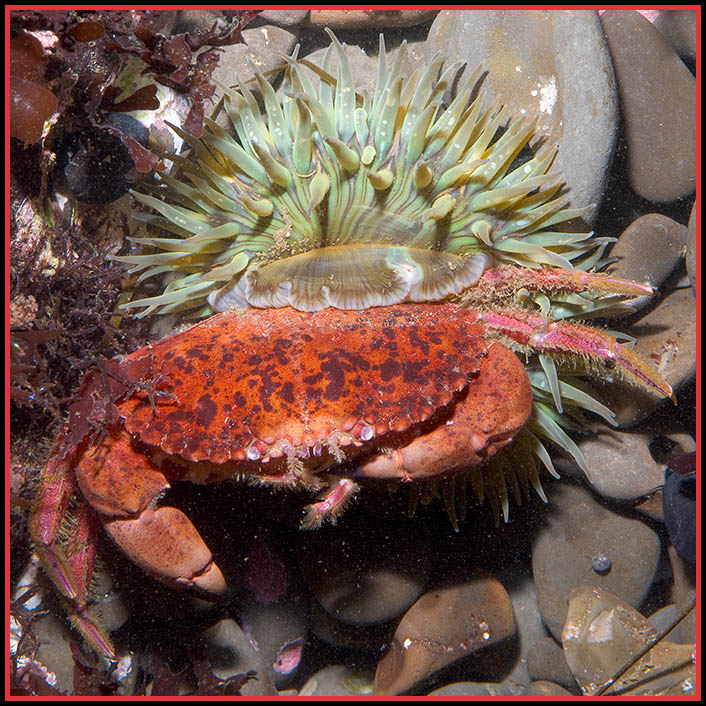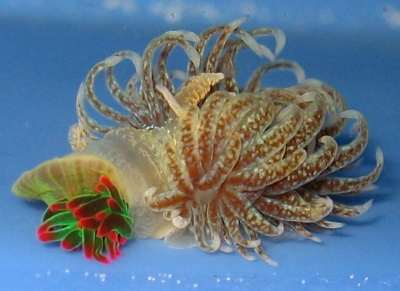Mike Spinak
pro member
Last week, my Sleeping Sea Lions photo provoked some discussion of planned photography versus spontaneous photography. This provoked me to now show one of my pictures which is closer to the spontaneous end of the spectrum than the planned.
In this case, I was out at the local tidepools, photographing many things, but mostly nudibranchs and anemones. I was finishing up for the day. I was way out at the further edges of the low intertidal zone. The last rays of the sun were fading. More importantly, the incoming tide was nipping at my heels. I had delayed leaving for so long that the incoming tide would soon overtake me, if I didn't leave immediately. I didn't even have time to pack my equipment; I was just carrying it unpacked in my hands... something I try to avoid doing, in a hard, jagged, uneven, wet, slippery, puddle spotted landscape, to avoid hurting myself and to avoid damaging my equipment.
So, I started to head back to the cliffs, with my hands full with my camera gear. I only got about 10 or 15 feet, when my shooting partner and I saw this aggregating anemone catching a red crab.
I see it fairly often, but it remains an amazing thing to see. To say that anemones intuitively seem slow and ungainly is an understatement. People often don't realize that they move at all. Indeed, people often don't realize that they are more animal than plant. Yet, anemones are capable hunters, and crabs are a staple of their diet. As in this case, they often catch prey considerably larger than themselves.
Additionally, the fascinating foreignness and unfamiliarity of these creatures adds to the interest. Not only is it a life and death struggle, but it's a life and death struggle between a crustacean and cniderian... one creature seemingly very different from ourselves, and the other creature seemingly incomprehensibly unlike ourselves.
I figured that I had until the next wave came in, probably within the next fifteen seconds, before the opportunity for the shot would be lost. I worked remarkably fast for me, considering that the camera was tripod mounted, the lens manually adjusted focus, and everything manually exposed, with off-camera flash. (The tide did, indeed, come in within about 15 seconds, and the opportunity was lost.) So, the results are rather sloppy, to say the least. I'm not very happy with the picture neither technically (especially the flash) nor compositionally, but... for me... the spectacle supersedes the photo's deficiencies, in this case.
I hope you enjoy it.

In this case, I was out at the local tidepools, photographing many things, but mostly nudibranchs and anemones. I was finishing up for the day. I was way out at the further edges of the low intertidal zone. The last rays of the sun were fading. More importantly, the incoming tide was nipping at my heels. I had delayed leaving for so long that the incoming tide would soon overtake me, if I didn't leave immediately. I didn't even have time to pack my equipment; I was just carrying it unpacked in my hands... something I try to avoid doing, in a hard, jagged, uneven, wet, slippery, puddle spotted landscape, to avoid hurting myself and to avoid damaging my equipment.
So, I started to head back to the cliffs, with my hands full with my camera gear. I only got about 10 or 15 feet, when my shooting partner and I saw this aggregating anemone catching a red crab.
I see it fairly often, but it remains an amazing thing to see. To say that anemones intuitively seem slow and ungainly is an understatement. People often don't realize that they move at all. Indeed, people often don't realize that they are more animal than plant. Yet, anemones are capable hunters, and crabs are a staple of their diet. As in this case, they often catch prey considerably larger than themselves.
Additionally, the fascinating foreignness and unfamiliarity of these creatures adds to the interest. Not only is it a life and death struggle, but it's a life and death struggle between a crustacean and cniderian... one creature seemingly very different from ourselves, and the other creature seemingly incomprehensibly unlike ourselves.
I figured that I had until the next wave came in, probably within the next fifteen seconds, before the opportunity for the shot would be lost. I worked remarkably fast for me, considering that the camera was tripod mounted, the lens manually adjusted focus, and everything manually exposed, with off-camera flash. (The tide did, indeed, come in within about 15 seconds, and the opportunity was lost.) So, the results are rather sloppy, to say the least. I'm not very happy with the picture neither technically (especially the flash) nor compositionally, but... for me... the spectacle supersedes the photo's deficiencies, in this case.
I hope you enjoy it.

Last edited:


